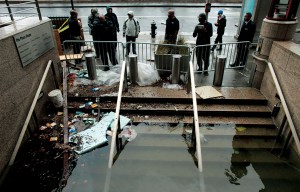FEMA spokesperson William Rukeyser described the ad-hoc, jumbled feel of the company’s impromptu space in the Forest Hills Tower like a scene from a hard-hit neighborhood, with hanging wires, antennas strapped to the ceiling, Post-It notes and sheets of paper with various instructions scattered about, and impromptu folding tables holding printers and other office equipment. Most seemed at a loss for words when assessing damages.
“It’s—It’s—It’s just a mess,” Durst Organization spokesperson Jordan Barowitz told The Commercial Observer less than a week after the storm hit, struggling to describe the destruction in Lower Manhattan.
 A collapsed crane infamously dangled for days over the One57 development above West 57th Street, perhaps personifying the frailty of a city faced with a challenge of mythic proportions.
A collapsed crane infamously dangled for days over the One57 development above West 57th Street, perhaps personifying the frailty of a city faced with a challenge of mythic proportions.
But if Poseidon played a hand in the devastation Sandy wreaked across the city, it was the Zeus-es of real estate who stood to defend it, with commercial real estate heavyweights like Bill Rudin, Stephen Ross and REBNY’s Steven Spinola stepping up to do everything possible to help companies impacted by the storm get back on their feet.
Lower Manhattan went dark for days, with companies shutting down due to power outages and flooding, and as reality set in that it would be days if not months before buildings would reopen, a flood of free temporary office space was offered up for companies displaced by the storm.
Among the firms to offer free space were giants like Muss Development, Forest City Ratner, Related Management, the Lightstone Group and Brookfield Properties.
On November 14, Silverstein Properties reopened 120 Wall Street for the first time since Hurricane Sandy flooded the 600,000-square-foot building’s basement and damaged electrical distribution equipment. Others followed suit, and as of December 10, just 15 of the 183 buildings in Lower Manhattan tracked by Jones Lang LaSalle remained closed, down from the 49 that were closed as of November 5.
The road to recovery, especially in low-lying coastal areas like Staten Island, Coney Island and the Rockaways, will take months, if not years. And as first reported in The Commercial Observer, The Daily News could be displaced from its home at 4 New York Plaza.
But even in that extreme case, owner Mort Zuckerman was moved by the outpouring of support he received, stating that what was “in one sense a terrible experience was in the other sense a wonderful experience,” expressing gratitude for a string of companies that helped get his media empire rolling again.
The storm will likely bring on a discourse that was inevitable, as building owners come to rethink where to place electrical equipment and generators, as the area known as flood Zone A, suddenly a universally-recognized area of the city, will likely be expanded.
As Mayor Bloomberg said just last week, “We may or may not see another storm like Sandy in our lifetimes, but I don’t think it’s fair to say that we should leave it to our children to prepare for the possibility.”



